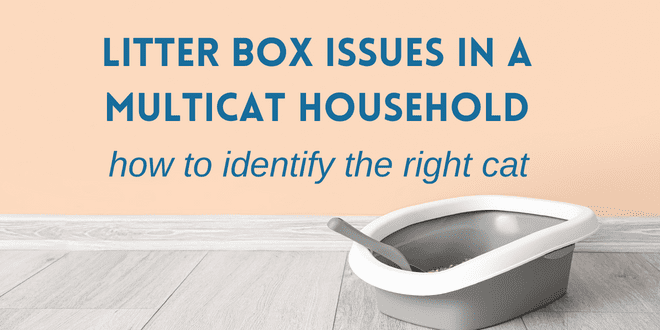
When it comes to a litter box problem in a multicat household, the first, and often most difficult step is to identify which cat is exhibiting the unwanted behavior. You may think you know which cat peed on the carpet but if you’re wrong, you could create major setbacks in the behavior plan. So how do you go about finding out which cat has turned your living room carpet into a giant litter box or has sprayed against your favorite antique chair? Unless you actually witness the behavior, it can be a guessing game, and not a fun one to play.
First Step: The Veterinary Clinic
Don’t automatically assume the problem is behavioral, even if your cats have been throwing hissy fits at one another. There could be an underlying medical cause for the behavior and you certainly wouldn’t want a cat to needlessly suffer. Additionally, stress can actually contribute to the onset of medical issues relating to the litter box. Get out that cat carrier because it’s time to make a veterinary clinic appointment.
With a multicat household, just how do you decide which cat to take to the veterinarian? If you have just two cats then it’s safest to bring them both. In a more cat-dense household, you may want to start with the most likely suspect. You also have the most accurate option of using video surveillance to help you identify the cat in question.
Best Method: Cats Under Surveillance
The most accurate way to determine which cat is eliminating outside of the litter box is to set up a surveillance camera. There are so many options on the market these days and they won’t break the budget. If you don’t already have a surveillance camera set up in your home, the most inexpensive one I’ve found is by Wyze Cam. The cameras run somewhere in the $20 range. A quick search on sites such as Amazon will provide you with many other inexpensive camera options as well if you don’t already have an indoor video system set up in your home. Most come with an app so you can easily see what’s happening in the house from your smartphone and view recorded footage. There are many brands of cameras so choose the one that’s right for you. No matter whether what type of camera you choose, it’s worth the investment to be able to accurately determine what’s happening when you aren’t around. Over the years, there will be many times, I’m sure, when having video evidence will help you solve a question about which cat displayed a particular behavior. Nothing is as reliable as camera footage when trying to determine the cause of a behavior.
Another Common, but not Really Reliable Method: Fluorescein
If urination or urine-marking is the problem, as opposed to defecation, you can also try identification through the use of fluorescein dye. This ophthalmic dye is used to detect problems on the surface of the eye but it has also been given orally to help identify which cat is urine-marking in a multicat household. The fluorescein will cause the urine to fluoresce under a woods lamp. You can have your veterinarian put the fluorescein in a capsule for you to administer to your cat. The problem with fluorescein is that it isn’t 100% reliable when it comes to causing urine to fluoresce. The other problem with this method is that it requires you to administer the capsule orally to your cat which may or may not go well, depending on how well trained your cat is when it comes to medicating.
Defecation Identification
Again, nothing beats the surveillance camera, but some veterinarians also suggest that clients add a few shavings of a non-toxic, brightly colored crayon to a cat’s food to see if it shows up in the feces after elimination. Don’t use this method without specific instructions from your veterinarian on how much to use.
Not Recommended: Cat Confinement
A method many cat parents have tried is to confine one cat away from the others to see if the problem persists. The problem with separating a cat is that it’s unreliable because the confined cat may be causing the stress to the cat who is actually doing the spraying, and the behavior may stop if the two cats are no longer sharing space.
What to do After You’ve Identified the Cat
Once you know which cat is engaging in the behavior, then it’s time to begin appropriate behavior modification. Treating a litter box problem is very individualized based on case specifics. Basically though, you’ll be working on three areas:
- Address underlying medical causes
- The litter box set-up
- Environmental/social factors
Remember, the first step is to start with the veterinarian to address any medical causes.
In a multicat household you have to make sure there are enough litter boxes and that they’re located in various areas around the home. Place a box in each cat’s personal area so one cat doesn’t have to cross another cat’s turf when there’s a need to eliminate. They also have to be the right size and type for each individual cat. Some cats will have specific substrate preferences as well.
Address any multicat tension and make sure everyone feels as if they have enough security and safety in the environment. When it comes to the litter box set-up, look at it from a cat’s point of view. Provide cleanliness, convenience and escape potential so each cat feels safe. Being in the litter box is a very vulnerable time so create set-ups that provide adequate visual warning time as well as escape potential.
As for relationships between the cats, start by making sure there are adequate resources available and that they’re located so no one has to compete or feel threatened. This applies to everything from the feeding stations, sleeping areas, places for climbing, litter boxes, and scratching posts. Then start working on helping the cats feel more comfortable around each other. Give them a reason to like each other instead of viewing each other as opponents and competitors for resources. In more extreme cases, that can mean doing a reintroduction.
Need More Information?
For more specifics on addressing litter box problems in a multicat household, check out the revised and updated edition of Pam’s best-selling book, Cat vs. Cat. This book, as well as Pam’s other books are available at bookstores and online. We’ve included Amazon links here on our site.
If you have a question regarding your cat’s health, please contact your veterinarian. This article is not intended as a replacement for your cat’s veterinary care.




